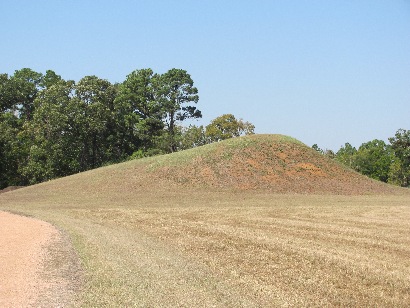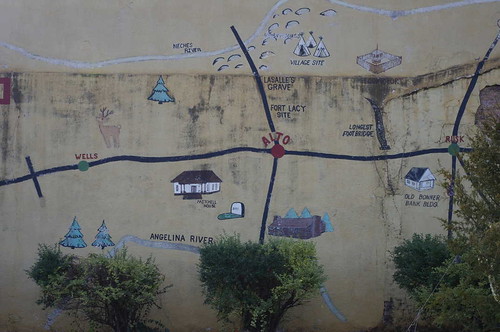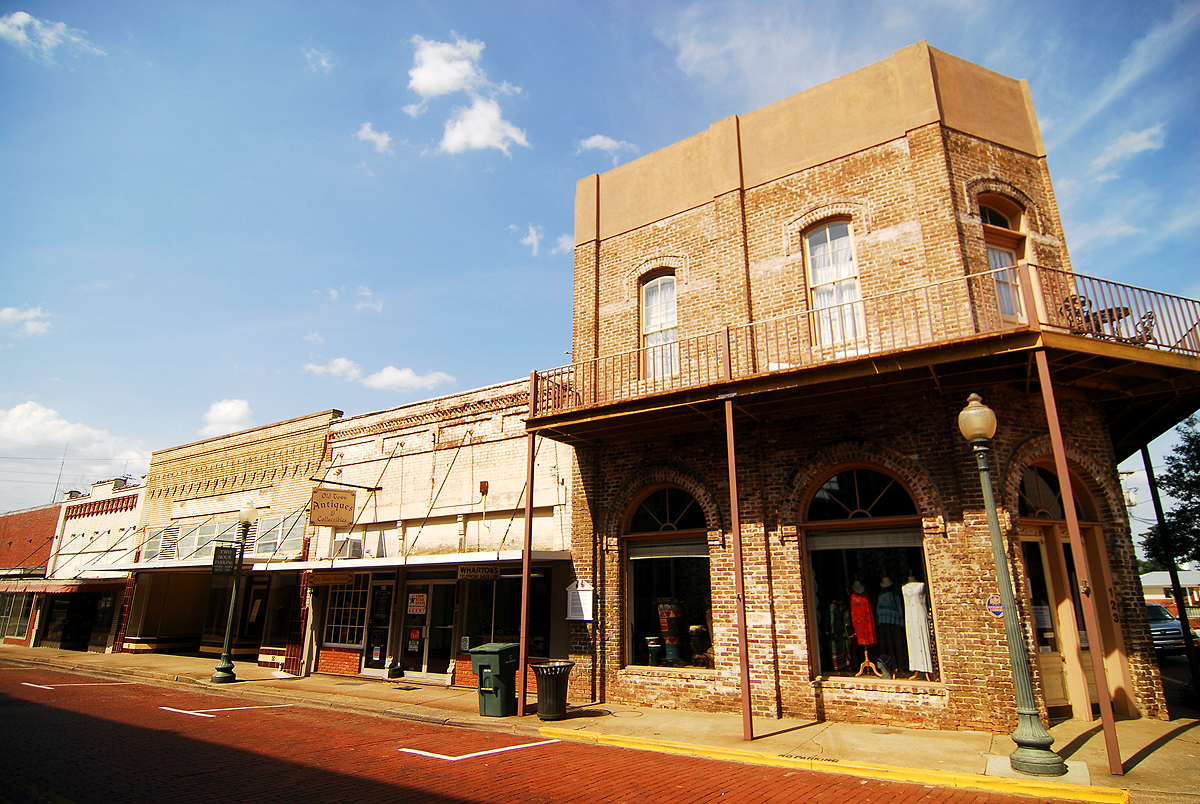Blue Highways: Caddo Mounds State Historic Site, Texas
Unfolding the Map
Click on Thumbnail for MapToday's post is a contemplation of time and space, brought about by William Least Heat-Moon's (LHM) own musings as he continues through Texas in Blue Highways. As he says, Black Elk looked from a great height and understood more than he saw, but LHM says he sees more than he understands. We all feel like that sometimes. Click on the thumbnail of the map to see, if not understand, our place in time, space and our own mental geography as we continue our journey.
Book Quote
"The sky turned the color of chimney soot. A massive, squared mound, quite unlike the surrounding hills, rose from a level valley; it had been the central element in a Caddoan Indian village a thousand years ago....
"....The aura of time the mound gave off seemed to mock any comprehension of its change and process - how it had grown from baskets of shoveled soil to the high center of Caddoan affairs to a hilly patch of blackberries. My rambling metaphysics was getting caught in the trap of reducing experience to coherence and meaning, letting the perplexity of things disrupt the joy in their mystery. To insist that diligent thought would bring an understanding of change was to limit life to the comprehensible.
"A raw scorch of lightning - fire from the thunderbird's eye - struck at the black clouds. A long peal. Before the rumble stopped, raindrops bashed the blackberry blossoms, and I ran for Ghost Dancing. Warm and dry, I watched the storm batter the old mound as it worked to wash the hill level again."
Blue Highways: Part 4, Chapter 1
 A Caddo burial mound at Caddo Mounds State Historic Site near Alto, Texas. Did William Least Heat-Moon contemplate this mound? Photo by Dana Goolsby at http://www.texasescapes.com. Click on photo to go to host site.
A Caddo burial mound at Caddo Mounds State Historic Site near Alto, Texas. Did William Least Heat-Moon contemplate this mound? Photo by Dana Goolsby at http://www.texasescapes.com. Click on photo to go to host site.
Caddo Mounds State Historic Site, Texas
Time is always a mystery to me. It's a dimension that seems to mock my comprehension of the universe and how I understand it. We live with time. Time moves constantly, forward without stopping, and we are all subject to it.
I understand, at least on an intuitive level, space. I don't exactly know what constitutes space, but I realize that we exist within space. I spread my arms and realize that I take up space. I understand that even where I seem solid, I really am a collection of cells and molecules and atoms. There is space between my constituent building blocks that can be penetrated by particles that are small enough, and so space permeates me.
I understand movement within space. I remember my basic physics that tells me that an object in motion will stay in motion until it encounters friction from other objects. I understand that everything moves within space, from the galaxies, stars and worlds to the basic atomic structures that form everything that we know.
But time is incomprehensible to me. Don't misunderstand, I don't spend a lot of energy worrying about time. But every once in a while, such as when I'm presented with a musing or some other reason to contemplate time, I still come back to the same questions. What really is time? Why does it constantly move forward? Can anything stop time? Is there one time, or are there many times moving in parallel? Once a certain time has come and gone, is it completely over, or does all time exist at once and do we only comprehend our own experience of it? Why is it that physics seem to indicate that time travel, or something approximating it, is only possible to the future but not to the past? I understand that there are paradoxes if one were to go back in time, the "if you kill your own grandfather would you cease to exist?" problem. But why does the past sometimes seem as if we can almost touch it, and the yet the future is always such a mystery?
I often wonder if, in large or small ways, I affect time, or if it is simply a machine set in motion and I am nothing to it. When I sit down to watch a football game and things start going bad for my team, I wonder if events might have been different had I not watched at all. In other words, was there a time and event crossroad occasioned by my choice to sit and watch the football game, or did it matter at all? Do my choices intermingle with others' choices and if so, do some have more influential choices than me that affect future time and events? Or are future events set and we careen toward them with no chance of altering them even if we knew what they were?
I have stood in historic spots like the Caddo Mounds that, as LHM says above, give off "an aura of time." I have stood in those spots and felt the past surround me and permeate me. I have even felt a connection with the past. A year or so ago, I was standing outside a Norbertine retreat center near Albuquerque, in the desert on the gentle slopes of a mesa near the Rio Grande. The silence was overwhelming, except when an occasional breeze rustled the native grasses. Suddenly, I felt a distinct thump. I'm not sure why there was a thump - maybe I had startled a rabbit and it had thumped a warning or, maybe it was something more metaphysical. The sound startled me to attention, and I looked around. There, just about a body length away from me, was a potsherd. It was the fragment of a pot used by the Indian dwellers of the area in a time long past. There was no telling how old it was. It sat there, white with a small section of the pot's design painted and still seemingly vibrant and alive. I bent down and picked it up and examined it, feeling its texture and marveling at the bit of design. For a moment, I felt connected to that past. I wondered if, in that same spot some unknown number of centuries ago, someone using that pot also heard a thump, looked around, and felt my future presence.
If you want a sense of the past and the present colliding, go to Rome. It is a living museum of the past, and you cannot walk into the Colosseum, with the sounds of Rome's traffic swirling around you, and not be instantly transported back to ancient Rome. You can almost see, vivid and vibrant in front of you, a newly constructed Colosseum, its benches filled with spectators watching a fight between a tiger and a prisoner, or a mock sea battle being staged on the flooded arena floor. At a gladiatorial contest, might a Roman patron suddenly sense the presence of an Ohio tourist in our present day standing beside him at the entrance to the arena, both observing what they can see and imagine, just for a moment before the feeling vanishes and the patron hurries to his seat to see the next battle and the tourist hurries to catch his wife who is already moving toward the Forum?
I think much more about time now that I am in my middle age. I wonder when my life will end and time will stop for me. I think of civilizations that have come and gone and will rise and fall. I wonder if time will eventually run down and stop, like a slowing watch that needs to be wound. Does the eventual end of the universe, whether that constitutes a big collapse or instead, the speeding of matter into a dispersed nothingness, mean that time itself will finally meet its end? I sit and wonder, and in that moment of wonder I am connected through time and space with all that was, is and will be. I am connected with all of those before and after me who have sat and will sit in wonder and contemplate the same mystery.
Then, like LHM, I go and resume my own journey through time and space as I comprehend them.
If you want to know more about Caddo Mounds
Texas Escapes: Caddo Mounds
Texas Historical Commission: Caddo Mounds
Texas State Historical Association: Caddoan Mounds
Where in the Hell Am I blog: Caddo Mounds
Wikipedia: Caddoan Mounds State Historic Site
Next up: North Zulch, Texas




 Saturday, January 22, 2011 at 12:48PM
Saturday, January 22, 2011 at 12:48PM

